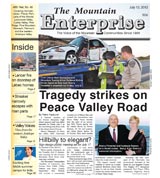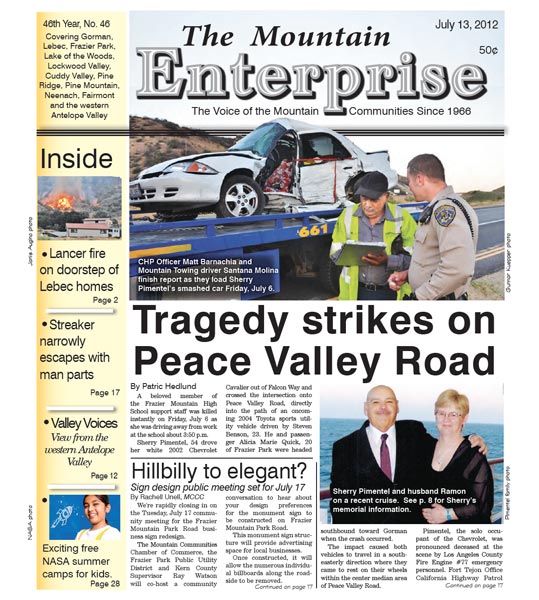By Patric Hedlund
Enchiladas and candid chat were on the menu at Azteca Mexican Restaurant in Antelope Acres on Friday, July 6 for officers of three rural town councils who began 2011 as embattled rivals rather than allies. Much of that year was spent “warring over boundaries,” as one council member put it.
The summit meeting included Colleen Schiller with Robert Kerekes (of the Antelope Acres Town Council); Gerard Conroy with Richard Skaggs (of the Oso Town Council that represents the Neenach area); and Barbara Rogers with Pat Chiodo (of the Fairmont Town Council).
The last nine months, they agreed, had seen many promises but little action on a growing list of shared concerns in their first close encounters with a major, utility-scale renewable energy construction project.
Blowing dust storms, a dropping water table, traffic hazards, fire hazards and prison-like walls of chain-link fences ruining once-pristine landscapes in the western Antelope Valley were hypothetical community concerns in 2011. They are daily realities in 2012.
Antelope Valley Solar Ranch One (AVSR1—being built by First Solar, Inc. for Exelon) is, they keep remembering, only the first of a possible 33 such facilities to be built in the area. Precedents are being set—and right now the precedents are not attractive.
“We’ve been taken advantage of by not being unified,” Antelope Acres’ Robert Kerekes said in an interview. “We are trying to approach this with a more unified voice…to come together as a unit.”
Landscaping
“Landscaping is one thing we can all agree on as a concern,” said Fairmont’s Barbara Rogers. “I didn’t move out here on 40 acres to be looking at endless rows of chain-link fences.”
First Solar’s permits from downtown Los Angeles County planning bureaucrats said the multinational company needed to plant only 109 Joshua trees as visual blight mitigation along the miles of fences the company has constructed. Laughter greeted this idea by all the representatives. “Joshua trees can’t be transplanted. They die,” the group explained. “And what,” Rogers asks, “Will 109 trees do to mitigate miles and miles of landscape damage?”
Oso Town Council members are interested in seeing tall, wide pomegranates (from arid areas of the Middle East) used to completely block the view of the fences, while creating a local crop and dust barrier (such as used in Wheeler Ridge).
Fairmont’s Pat Chiodo, (whose brother, he says, owns the AVTree Farm in Antelope Valley where Chiodo works), is adamant, “I’m the expert,” he said, “what is needed is Afghani pine trees.” He’s told attendees at numerous meetings the same thing. It is estimated that about 4,000 trees would be needed to shield the AVSR1 plant.
Oso Town Council’s Gerard Conroy is reported by witnesses at the July 6 meeting to have told Chiodo he’d feel more comfortable with him as the new council coalition’s “tree guy” for their negotiations with First Solar if Chiodo could explain the rumors circulating in the area that Chiodo already has a contract with First Solar.
“Pat got up and threw a contract on the table,” Skaggs said in an interview. Conroy read the contract closely. Parties agree that it was signed in November 2011, paid $20,000 up front and $60 an hour as a consultant.
Skaggs said, “it has a confidentiality clause. He wasn’t supposed to tell anyone he had this. They tried to get me to sign the same thing. I told them I would do business with them (for a low-emissions fuel additive he manufactures), but that I wouldn’t sign a confidentiality agreement…. The appearance of a conflict of interest undermines credibility,” Skaggs said, “So I tell everyone—in front of First Solar executives—that I’ll be happy to do business with them, [but] out in the open.”
Heart Attack
On Monday, July 9 when a new meeting was scheduled, Pat Chiodo called to say he was driving himself to the emergency room of the Antelope Valley Hospital. “I was having a heart attack,” he said when this reporter spoke with him. “I’m out of this ballgame.”
That may change. He is reported to be talking with many people this week, from the hospital.
Editorial: Conflict of interest isn’t pixie dust
By Patric Hedlund, Editor
Print newspaper editors tend to live by very strict rules if we are serious about our profession and about what our work means to the public which we serve.
Ethics are living, breathing, daily companions in our lives. We talk about them in our office, in our lunch room, in our conferences, on vacations, while hiking, with our attorneys and on at least three different national ethics hot lines. We must be wary about where we invest; what we talk about and with whom; about how we socialize; whom we date; and we always buy our own lunch. We appreciate an innocent gesture, but we can’t accept gifts. We give them back.
The importance of professional ethics and how we must live in order to avoid even the perception of a conflict of interest is based on the need to keep our reporting credible. This is rigorously taught and then reinforced in newspaper newsrooms. Am I getting boring on this topic yet?
Yes, print editors can be fanatics—and I agree that both our readers and we can find exceptions in the profession who have failed to live up to these standards—but our code of ethics sharpens a great skill in us. It makes us highly sensitive to conflicts of interest looming in the paths of those about whom we report.
This is especially painful in watching members of volunteer boards as they get close to the line of questionable conflicts. Kern County Supervisor Ray Watson’s appointed Municipal Advisory Council is a humming hive of conflicts of interest. Elected boards can be even more painful to watch if they are not vigilant over their own potential conflicts and ethical challenges.
Both we and the Kern County Grand Jury find it alarming to watch Lebec County Water District board member Millie Karr’s refusal to recuse herself and leave the room when an agenda item pops up that may shield her husband from legal and financial liabilities.
Bob Karr may be civilly vulnerable for allegedly illegal actions he took in 2009 while installing a private 12-inch line for developers and connecting it to the system when he was a member of the same board. This may affect Millie Karr, the current board treasurer, economically and personally.
Those elected to do the public’s business should not participate in deliberations over matters which could affect their own finances. But at the July 10 board meeting, Karr again ignored that fact with big round eyes. This is a game of pretend. Karr pretends she doesn’t see the self-serving conflict of interest, so maybe no one else will see either. It is flat wrong for the other members of the LCWD board to adopt that kind of magical thinking. Their own credibility is suffering. The public is not that stupid.
A similar problem is stalking the western Antelope Valley. We salute people doing good business. But an elected representative wearing two hats, keeping one of them secret, is simply wrong. If one takes money secretly from the very company with which their council is negotiating, what exactly is that company buying?
Under the current L.A. County Rural Town Council structure, this may not be illegal, but secretly mixing business with elected service is a breach of public trust. It erodes ethics, shreds credibility and creates a climate of corruption. Full public disclosure is the only remedy.
This is part of the July 13, 2012 online edition of The Mountain Enterprise.
Have an opinion on this matter? We'd like to hear from you.


